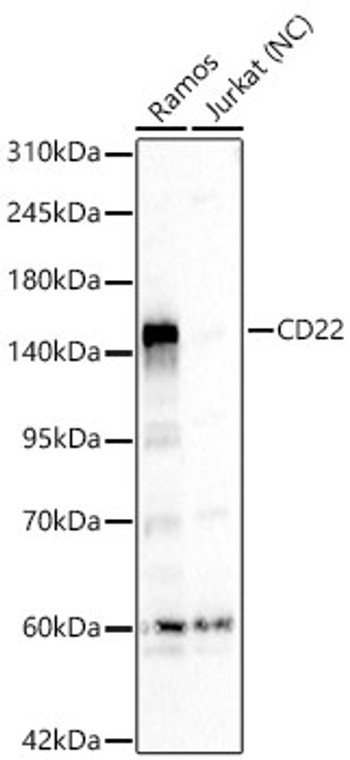| Host: |
Rabbit |
| Applications: |
WB/ELISA |
| Reactivity: |
Human |
| Note: |
STRICTLY FOR FURTHER SCIENTIFIC RESEARCH USE ONLY (RUO). MUST NOT TO BE USED IN DIAGNOSTIC OR THERAPEUTIC APPLICATIONS. |
| Clonality: |
Polyclonal |
| Conjugation: |
Unconjugated |
| Isotype: |
IgG |
| Formulation: |
PBS with 0.05% Proclin300, 50% Glycerol, pH 7.3. |
| Purification: |
Affinity purification |
| Concentration: |
Lot specific |
| Dilution Range: |
WB:1:500-1:1000ELISA:Recommended starting concentration is 1 Mu g/mL. Please optimize the concentration based on your specific assay requirements. |
| Storage Instruction: |
Store at-20°C for up to 1 year from the date of receipt, and avoid repeat freeze-thaw cycles. |
| Gene Symbol: |
CD22 |
| Gene ID: |
933 |
| Uniprot ID: |
CD22_HUMAN |
| Immunogen Region: |
1-100 |
| Specificity: |
A synthetic peptide corresponding to a sequence within amino acids 1-100 of human CD22 (NP_001762.2). |
| Immunogen Sequence: |
MHLLGPWLLLLVLEYLAFSD SSKWVFEHPETLYAWEGACV WIPCTYRALDGDLESFILFH NPEYNKNTSKFDGTRLYEST KDGKVPSEQKRVQFLGDKNK |
| Tissue Specificity | B-lymphocytes. |
| Post Translational Modifications | Phosphorylation of Tyr-762, Tyr-807 and Tyr-822 are involved in binding to SYK, GRB2 and SYK, respectively. Phosphorylation of Tyr-842 is involved in binding to SYK, PLCG2 and PIK3R1/PIK3R2. Phosphorylated on tyrosine residues by LYN. |
| Function | Most highly expressed siglec (sialic acid-binding immunoglobulin-like lectin) on B-cells that plays a role in various aspects of B-cell biology including differentiation, antigen presentation, and trafficking to bone marrow. Binds to alpha 2,6-linked sialic acid residues of surface molecules such as CD22 itself, CD45 and IgM in a cis configuration. Can also bind to ligands on other cells as an adhesion molecule in a trans configuration. Acts as an inhibitory coreceptor on the surface of B-cells and inhibits B-cell receptor induced signaling, characterized by inhibition of the calcium mobilization and cellular activation. Mechanistically, the immunoreceptor tyrosine-based inhibitory motif domain is phosphorylated by the Src kinase LYN, which in turn leads to the recruitment of the protein tyrosine phosphatase 1/PTPN6, leading to the negative regulation of BCR signaling. If this negative signaling from is of sufficient strength, apoptosis of the B-cell can be induced. |
| Protein Name | B-Cell Receptor Cd22B-Lymphocyte Cell Adhesion MoleculeBl-CamSialic Acid-Binding Ig-Like Lectin 2Siglec-2T-Cell Surface Antigen Leu-14Cd Antigen Cd22 |
| Database Links | Reactome: R-HSA-198933Reactome: R-HSA-5690714Reactome: R-HSA-983695 |
| Cellular Localisation | Cell MembraneSingle-Pass Type I Membrane Protein |
| Alternative Antibody Names | Anti-B-Cell Receptor Cd22 antibodyAnti-B-Lymphocyte Cell Adhesion Molecule antibodyAnti-Bl-Cam antibodyAnti-Sialic Acid-Binding Ig-Like Lectin 2 antibodyAnti-Siglec-2 antibodyAnti-T-Cell Surface Antigen Leu-14 antibodyAnti-Cd Antigen Cd22 antibodyAnti-CD22 antibodyAnti-SIGLEC2 antibody |
Information sourced from Uniprot.org
12 months for antibodies. 6 months for ELISA Kits. Please see website T&Cs for further guidance




